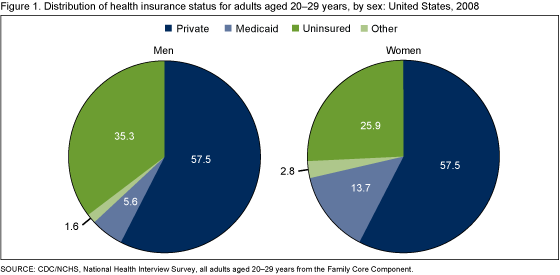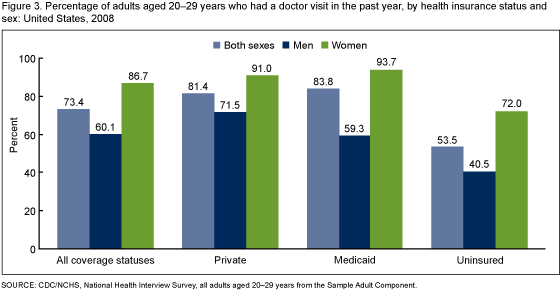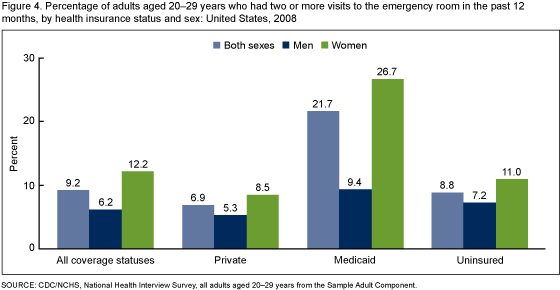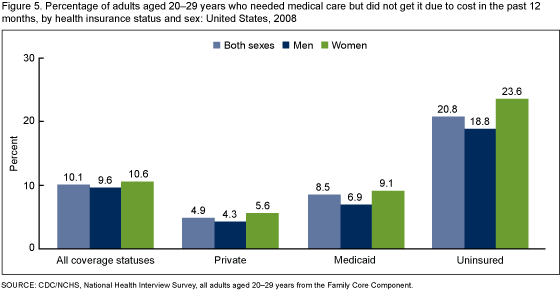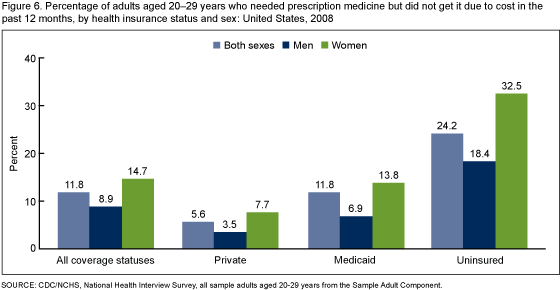Access to and Utilization of Medical Care for Young Adults Aged 20-29 Years: United States, 2008
NCHS Data Brief No. 29, February 2010
On this Page
- Key findings
- Almost 13 million young adults aged 20-29 years did not have health insurance coverage in 2008 (30%).
- Overall, 70% of young adults aged 20-29 years had a usual source of medical care.
- Almost three-quarters of young adults aged 20-29 years had a doctor visit in the past year, 87% of women and 60% of men.
- Almost 1 in 10 young adults aged 20-29 years had two or more emergency room visits in the past 12 months.
- Overall, 10% of young adults aged 20-29 years needed medical care but did not get it due to cost in the past 12 months.
- Twelve percent of young adults aged 20-29 years needed prescription medication but did not get it due to cost in the past 12 months.
- Summary
- Definitions
- Data source and methods
- About the authors
- References
- Suggested citation
PDF Version (1.1 MB)
Robin A. Cohen, Ph.D., and Barbara Bloom, M.P.A.
Key findings
Data from the National Health Interview Survey
- Almost 13 million young adults aged 20-29 years did not have health insurance coverage in 2008 (30%).
- Young men aged 20-29 years were 36% more likely than young women of that age to be uninsured.
- Young adults aged 20-29 years without insurance were less likely to have a usual source of medical care (44%) than were those with private insurance (80%) or Medicaid (84%).
- Young adults aged 20-29 years without insurance were four times as likely (21%) as those with private insurance (5%) and two times as likely as those with Medicaid (9%) to have unmet medical need.
- Uninsured young women aged 20-29 (33%) were almost twice as likely as uninsured young men of that age (18%) to have had unmet prescription medication need in the past 12 months.
Health insurance status is a primary indicator of access to medical care in the United States. Historically, in the United States, lack of health insurance coverage has been highest among younger adults (1). In 2008, young adults in the United States aged 20-29 years were almost twice as likely (31%) as adults aged 30-64 years (17%) to lack health insurance coverage. As young adults transition into the workforce, they may be dropped from public health coverage at age 19 or from their parents’ policies upon high school or college graduation (2). The low wages or temporary jobs typically available to young adults upon graduation often come with limited or no health benefits. Young adulthood is a high-risk period for unintended pregnancy, sexually transmitted diseases, substance abuse, and injuries (3). Pregnancy rates are highest among women aged 20-29 years, which is directly related to the need for health care services (4). Disruption of health insurance coverage can introduce barriers to health care and leave young adults vulnerable to high out-of-pocket expenses in the event of a serious illness or injury (5).
Keywords: health insurance, access to unmet medical need/medical care, National Health Interview Survey, usual source of care
Almost 13 million young adults aged 20-29 years did not have health insurance coverage in 2008 (30%).
Among young adults aged 20-29 years, men were 36% more likely than women to be uninsured (35% compared with 26%).
Equal percentages of men and women aged 20-29 years had private health insurance coverage. However, young women were more than twice as likely as young men to have Medicaid coverage.
Overall, 70% of young adults aged 20-29 years had a usual source of medical care.
Those without insurance were less likely to have a usual source of medical care (44%) than were those with private insurance (80%) or Medicaid (84%).
Overall, young women aged 20-29 years were more likely to have a usual source of medical care than young men.
Young women with private coverage (91%) were more likely than young men with private coverage (70%) to have a usual source of medical care.
Among uninsured young adults, women (50%) were more likely than men (39%) to have a usual source of medical care.
Almost three-quarters of young adults aged 20-29 years had a doctor visit in the past year, 87% of women and 60% of men.
Young adults aged 20-29 years without insurance were less likely to have a doctor visit in the past year (54%) than were those with private insurance (81%) or Medicaid (84%).
Approximately 9 out of 10 young women aged 20-29 years with private insurance had a doctor visit in the past year compared with 7 out of 10 young men.
Among young adults with Medicaid coverage, more young women (94%) had a doctor visit in the past year compared with young men (59%).
Uninsured young women were 75% more likely than uninsured young men to have had a doctor visit in the past year.
Almost 1 in 10 young adults aged 20-29 years had two or more emergency room visits in the past 12 months.
Young women were twice as likely to have had two or more emergency room visits in the past 12 months (12%) as young men (6%).
Among young adults with Medicaid, women (27%) were three times as likely as men (9%) to have had two or more emergency room visits in the past 12 months.
Overall, 10% of young adults aged 20-29 years needed medical care but did not get it due to cost in the past 12 months.
Young adults aged 20-29 years without insurance were four times as likely (21%) as those with private insurance (5%) and two times as likely as those with Medicaid (9%) to have unmet medical need.
Uninsured young women were more likely to have unmet medical need (24%) than uninsured young men (19%).
Twelve percent of young adults aged 20-29 years needed prescription medication but did not get it due to cost in the past 12 months.
Young adults aged 20-29 years without insurance were more likely to have had unmet prescription medication need in the past 12 months (24%) than those with either private insurance (6%) or Medicaid (12%).
Young women aged 20-29 years were more likely to have unmet prescription medication need in the past 12 months (15%) than were young men (9%).
Uninsured young women (33%) were almost twice as likely as uninsured young men (18%) to have had unmet prescription medication need in the past 12 months.
Summary
The majority of young adults aged 20-29 years (58%) had private health insurance coverage. Although young men and young women were equally likely to have private health insurance coverage, young women with private coverage were more likely to utilize medical services than young men with the same coverage.
Approximately 13 million young adults aged 20-29 years did not have health insurance coverage in 2008 (30%). Young men were more likely than young women to be uninsured. Uninsured young women were more likely than uninsured young men to have unmet medical and prescription medication needs, but also to have had a usual source of medical care, a doctor visit in the past year, and two or more emergency room visits in the past 12 months.
Definitions
Health insurance coverage: Health insurance is broadly defined to include both public and private payors who cover medical expenditures incurred by a defined population in a variety of settings. This includes persons covered by private health insurance, whether offered through employment or purchased individually, and persons covered by public programs such as Medicare, Medicaid, Children’s Health Insurance Program (CHIP), and other state-sponsored programs. Persons with only Indian Health Service coverage or having only a private plan that paid for one type of service such as accidents or dental care were not considered to be covered by health insurance. In this report, coverage is measured at one point in time, which is the day of the NHIS interview.
Private insurance: Private insurance is indicated when respondents report that they were covered by private health insurance through an employer, union, or individual purchase. Private health insurance includes managed care such as health maintenance organizations (HMOs). It does not include military health plans.
Medicaid: Medicaid is indicated when respondents report that they were covered by Medicaid. Individuals were also considered covered by Medicaid if they reported coverage by CHIP, or other state-sponsored plans. In this analysis, health insurance categories are hierarchical, and adults covered by both private insurance and Medicaid were considered to have private insurance.
Uninsured: Uninsured status is indicated when respondents report that they did not have coverage under private health insurance, Medicare, Medicaid, CHIP, another state sponsored health plan, other government sponsored programs, or a military health plan (TRICARE, VA, or CHAMP-VA). A person was also defined as uninsured if he or she had only Indian Health Service coverage or had only a private plan that paid for one type of service such as accidents or dental care.
Doctor or other health care professional contact: This may include a contact while a person is in the hospital as well as a contact from a home visit, but not a contact made to arrange appointments.
Doctor or other health professional: Doctor refers to medical doctor (M.D.) and osteopathic physician (D.O.), including general practitioners and all types of specialists (such as internists, gynecologists, obstetricians, psychiatrists, and ophthalmologists). Other health care professional includes physician assistants, psychologists, nurses, physical therapists, chiropractors, etc.
Emergency room visit: This includes all emergency room visits even those that resulted in a hospital admission.
Unmet need: A person was considered to have unmet need if he or she did not get medical care due to cost or did not get a prescription drug due to cost in the past 12 months.
Usual source of care: Usual source of care was measured by asking the respondent, “Is there a place that you USUALLY go when you are sick or need advice about your health?” Persons who report the emergency department as their usual source of care are defined as having no usual source of care in this report.
Data source and methods
Data from the 2008 National Health Interview Survey (NHIS) were used for this analysis. NHIS is conducted continuously throughout the year by interviewers of the U.S. Census Bureau for the National Center for Health Statistics (NCHS), Centers for Disease Control and Prevention. NHIS collects information about the health and health care of the civilian, noninstitutionalized U.S. population. Interviews are conducted in respondents’ homes, but follow-ups to complete interviews may be conducted over the telephone. Questions about health insurance coverage and did not get medical care due to cost are asked of family respondents in the family component of the survey. Other questions on access and utilization are from the sample adult component. In 2008, information was collected on a total of 9,874 persons aged 20-29 years from the family core component and 3,609 persons aged 20-29 years from the sample adult component of the survey. For further information about NHIS, including the questionnaire, see the NHIS Website
NHIS is designed to yield a sample representative of the civilian noninstitutionalized population of the United States, and this analysis uses weights to produce national estimates. Data weighting procedures are described in more detail elsewhere (6). Point estimates and estimates of corresponding variances for this analysis were calculated using SUDAAN software (7) to account for the complex sample design of the NHIS. The Taylor series linearization method was chosen for variance estimation. Most estimates shown in this report meet the NCHS standard of reliability (relative standard error less than or equal to 30%). Estimates with a relative standard error more than 30% but less than or equal to 50% are preceded by an asterisk (*). Differences between percentages were evaluated using two-sided significance tests at the 0.05 level. Terms such as “higher than” and “less than” indicate statistically significant differences. Terms such as “similar” and “no difference” indicate that the statistics being compared were not significantly different. Lack of comment regarding the difference between any two statistics does not necessarily suggest that the difference was tested and found to be not significant.
Most access and utilization measures in this report are based on the 12 months prior to interview, with the exception of a usual source of care. Usual source of care is based on a person’s status at the time of interview. Insurance coverage is also based on a person’s status at the time of interview. Therefore, an individual’s insurance status may have been different at the time health services were sought or received.
About the authors
Robin A. Cohen and Barbara Bloom are with the Centers for Disease Control and Prevention’s National Center for Health Statistics, Division of Health Interview Statistics.
References
- National Center for Health Statistics. Health, United States, 2008 With special feature on the health of young adults. Hyattsville, MD. 2009.
- Kriss JL, Collins SR, Mahato B, Gould E, Schoen C. Rite of passage? Why young adults become uninsured and how new policies can help, 2008 update. The Commonwealth Fund. Issue Brief. May 2008.
- Callahan ST, Cooper WO. Uninsured and health care access among young adults in the United States. Pediatrics 116:88-95. 2005.
- Ventura SJ, Abma JC, Mosher WD, Henshaw SK. Estimated pregnancy rates for the United States, 1990-2005: An update. National vital statistics reports; vol 58 no 4. Hyattsville MD: National Center for Health Statistics. 2009.
- Collins SR. Rising numbers of uninsured young adults: Causes, consequences, and new policies. Invited Testimony. Subcommittee on Federal Workforce, Postal Service, and the District of Columbia Committee on Oversight and Government Reform United States House of Representatives Hearing on “Providing Health Insurance to Young Adults Enrolled as Dependents in FEHBP.” 2008.
- Botman SL, Moore TF, Moriarity CL, Parsons VL. Design and estimation for the National Health Interview Survey, 1995-2004. National Center for Health Statistics. Vital Health Stat 2(130). 2000
- Research Triangle Institute. SUDAAN (Release 9.1). Research Triangle Park, NC: Research Triangle Institute. 2004.
Suggested citation
Cohen RA, Bloom B. Access to and utilization of medical care for young adults aged 20-29 years: United States, 2008. NCHS data brief, no 29. Hyattsville, MD: National Center for Health Statistics. 2010.
Copyright information
All material appearing in this report is in the public domain and may be reproduced or copied without permission; citation as to source, however, is appreciated.
National Center for Health Statistics
Edward J. Sondik, Ph.D., Director
Jennifer H. Madans, Ph.D., Associate Director for Science
Division of Health Interview Statistics
Jane F. Gentleman, Ph.D., Director
- Page last reviewed: November 6, 2015
- Page last updated: February 24, 2010
- Content source:


 ShareCompartir
ShareCompartir
